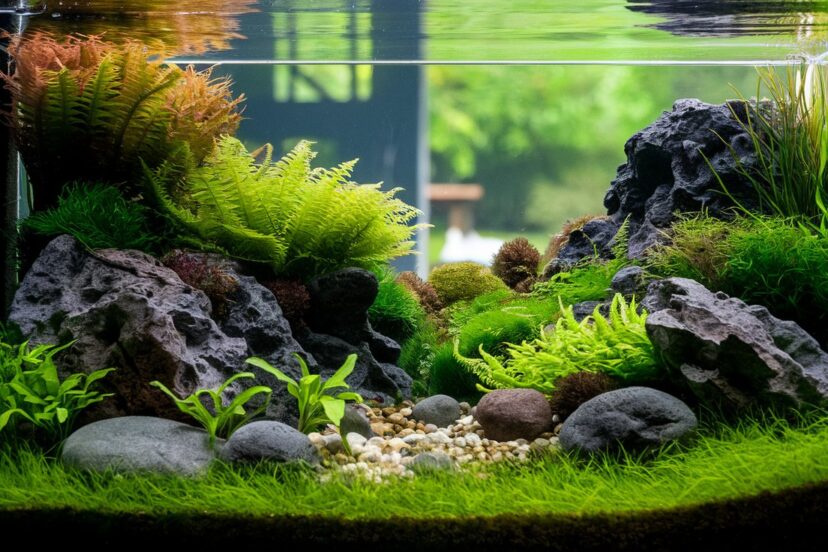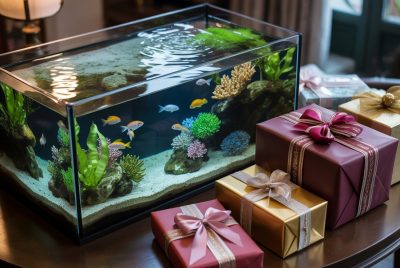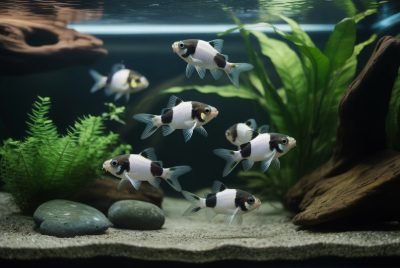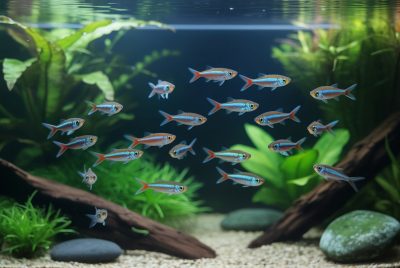Aquascaping Ideas with Rocks
*We may earn a commission for purchases made using our links. Please see our disclosure to learn more.
Imagine transforming your aquarium into a miniature underwater mountain range, a serene river bed, or an otherworldly alien landscape, all through the strategic placement of rocks. If you’re looking for aquascaping ideas with rocks, this guide will inspire you to go beyond simple decoration and embrace the art form that blends aesthetic principles with ecological understanding to create living masterpieces.
From the minimalist precision of Japanese Iwagumi layouts to the dramatic overhangs of cliff-inspired designs, rocks provide the foundation upon which truly memorable aquascapes are built. This comprehensive guide will walk you through the creative possibilities, practical techniques, and expert insights needed to harness the full potential of rocks in your underwater creations.
Key Takeaways
- Rocks serve multiple purposes in aquascaping: creating structure, influencing water chemistry, and providing biological benefits
- Different rock types (like dragon stone, seiryu stone, lava rock) offer unique aesthetic and functional properties
- Strategic placement techniques like the Golden Ratio and focal points can dramatically improve your design
- Complementing rocks with appropriate plants creates a balanced, natural-looking ecosystem
- Regular maintenance is essential to preserve both the beauty and health of your rock-based aquascape
“In aquascaping, rocks are not mere decorations—they are the bones of the landscape, telling stories of geological processes and natural history. Like a painter uses color, the aquascaper uses stone to evoke emotion and create living poetry beneath the water’s surface.”
— Takashi Amano, founder of Aqua Design Amano and pioneer of nature aquarium concept
Top Recommended Products for Rock Aquascaping
1. LifeGard Aquatics Dragon Stone
Transform your aquarium or terrarium into a stunning natural habitat with the Lifegard Aquatics Dragon Ohko Aquascaping Rocks. This 25-pound kit includes a mix of small, medium, and large natural dragon stones—perfect for crafting dramatic underwater landscapes or creating cozy hideouts for shrimp, small fish, or reptiles. These 100% natural stones are safe for all freshwater setups and won’t alter water quality. Whether you're aquascaping a fish tank, designing a reptile enclosure, or decorating a garden feature, this versatile kit brings visual appeal and practical benefits.
- Natural Appeal: Beautiful textures and earthy brown tones enhance the look of any aquatic or terrarium setup.
- Safe for Aquatic Life: Does not alter water parameters and is safe for shrimp, fish, and freshwater environments.
- Versatile Use: Ideal for aquariums, terrariums, ponds, and even garden decorations.
- Cleaning Required: Rocks may arrive dusty or dirty from shipping and require a rinse before use.
- Irregular Sizes: Stone sizes may vary more than expected, which may not suit all design plans.
- Limited Color Options: Available only in natural brown, which may not match all themed setups.
These uniquely textured rocks feature intricate holes and crevices that create instant visual interest while providing excellent hiding spots for small fish and shrimp. The warm, earthy tones complement virtually any aquascape style, particularly nature and Iwagumi designs.
2. Fluval Stratum Volcanic Soil Substrate
Give your planted aquarium the perfect foundation with Fluval Bio-Stratum, a mineral-rich volcanic soil designed to support healthy aquatic plant development. This 8.8-pound bag of substrate promotes vibrant growth and rich coloration, while creating ideal conditions for beneficial bacteria to thrive. The lightweight 1mm granules enhance root penetration and improve biological filtration, making it a top choice for new and established freshwater tanks. With its ability to stabilize ammonia and foster balanced water parameters, Bio-Stratum is more than just soil—it’s a full ecosystem booster in a bag.
- Boosts Plant Growth: Enriched with essential nutrients to enhance plant development and vivid coloration.
- Biological Filtration: Contains dormant nitrifying bacteria to kickstart the nitrogen cycle and support water health.
- Root-Friendly Texture: Fine, non-compacting granules allow roots to spread easily for optimal growth.
- Higher Price Point: Slightly more expensive than basic substrates.
- Not for Hard Water Tanks: May not perform optimally in hard or alkaline water setups.
- Can Cloud Water Initially: May cause temporary water cloudiness when first added.
This specialized substrate works perfectly with rock-based layouts, providing essential nutrients for plant growth while maintaining stable water parameters. Its dark coloration creates excellent contrast with lighter-colored stones, making your rock formations stand out.
3. Aqueon Aquarium Silicone Sealant
The Aqueon Silicone Sealant is a must-have for aquarium hobbyists and DIYers who need a reliable, waterproof solution for sealing and repairing tanks. This 3-ounce tube contains 100% non-toxic, aquarium-safe silicone that’s ideal for both freshwater and saltwater environments. Designed to remain permanently flexible, it won’t crack or shrink over time, making it perfect for creating strong, long-lasting bonds. Whether you're building a custom tank or fixing a small leak, Aqueon’s clear silicone delivers a seamless, professional finish.
- Aquarium-Safe Formula: 100% non-toxic silicone safe for all aquatic life.
- Long-Lasting Seal: Flexible and durable—resists cracking or shrinking over time.
- Easy Application: Simple to use and adheres quickly for fast repairs or builds.
- Small Tube Size: May not be enough for larger projects or multiple repairs.
- Curing Time Required: Needs 24–48 hours to fully cure before reintroducing water or fish.
- Limited Color Options: Only available in clear or black silicone.
A must-have for creating custom rock structures, this aquarium-safe silicone allows you to securely bond stones together for more dramatic vertical arrangements or to prevent potential collapses that could damage your tank or harm aquatic life.
4. Seachem Flourish Excel
Seachem Flourish Excel is a powerful and easy-to-use liquid supplement designed to deliver a bioavailable source of organic carbon—essential for vibrant, healthy plant growth in freshwater aquariums. Ideal for planted tanks, this 500 ml bottle also helps promote iron absorption and supports photosynthesis by bypassing the need for plants to build complex carbon chains. Safe for fish and effective in boosting plant vitality, Flourish Excel is a smart choice for aquascapers looking to enhance their underwater gardens without CO₂ systems.
- Boosts Plant Growth: Provides a direct source of organic carbon to enhance photosynthesis and plant development.
- Supports Iron Absorption: Promotes the more absorbable ferrous (Fe²⁺) form of iron for healthier plants.
- Easy to Dose: Simple cap-measured instructions make daily or alternate-day use hassle-free.
- Not Ideal for All Plants: Can be harsh on sensitive species like Anacharis if used daily.
- Requires Consistent Use: Best results come with regular dosing, which may be inconvenient for some users.
- Slightly Pricey: More expensive compared to basic liquid fertilizers or carbon alternatives.
This liquid carbon supplement enhances the growth of plants around your rock formations, ensuring your aquascape maintains the perfect balance between stone and vegetation. Healthy plant growth prevents algae buildup on your carefully selected rocks.
Understanding Rock Types for Aquascaping
The foundation of any successful rock-based aquascape begins with selecting the right materials. When exploring aquascaping ideas with rocks, it’s essential to understand how different rock types not only create distinct visual impressions but also influence your aquarium’s water chemistry and overall ecosystem health. Choosing the right rocks ensures both aesthetic harmony and a balanced environment for aquatic life.
Inert vs. Reactive Rocks
Before diving into your aquascaping journey, especially when exploring aquascaping ideas with rocks, it’s crucial to understand how different stones interact with water. Inert rocks like granite, slate, and quartz are ideal for most aquariums since they won’t alter water chemistry. These stable materials are perfect for planted tanks and soft water species, offering creative freedom without compromising aquatic health.
On the other hand, reactive rocks such as limestone, marble, and certain decorative stones can gradually release minerals that raise water hardness and pH. While this can be beneficial for African cichlids and other hard water species, it may cause issues in setups requiring soft, acidic conditions.
A simple way to test a rock’s reactivity is by placing a few drops of vinegar on its surface. If it fizzes or bubbles, the rock contains calcium carbonate and could shift your tank’s parameters over time. For sensitive aquascapes—especially those with specific plant or fish needs—stick with confirmed inert rocks or prepare for regular water testing and maintenance.
Popular Rock Types for Aquascaping
Dragon Stone (Ohko Stone)
Dragon Stone is a favorite in many aquascaping ideas with rocks due to its intricate, weathered appearance. With a honey-brown hue and naturally occurring holes and ridges, it creates depth and drama in any aquascape. Its inert nature ensures it won’t impact water parameters, making it ideal for both beginners and advanced hobbyists. Dragon Stone works especially well in Iwagumi-style layouts, providing stunning contrast with vibrant green aquatic plants and offering cozy hideaways for curious fish.
Seiryu Stone
Seiryu Stone has become synonymous with Iwagumi-style aquascaping, featuring sharp, angular edges and subtle blue-gray coloration. While visually striking, remember that these stones gradually release minerals that increase water hardness and pH, requiring monitoring in sensitive setups. Seiryu’s distinctive layered appearance mimics the stratified rock formations found in mountainous landscapes, making it perfect for creating dramatic peaks and valleys in your composition.
Lava Rock
Lava Rock combines visual appeal with remarkable functionality. Its highly porous structure provides expansive surface area for beneficial bacteria colonization, enhancing biological filtration. Additionally, these pores make excellent attachment points for moss and epiphytic plants, allowing for creative “living rock” arrangements. Available in red and black varieties, lava rock’s lightweight nature allows for larger formations without putting excessive pressure on tank glass.
Black River Rocks
Black River Rocks offer smooth, polished surfaces that create a distinctly different aesthetic from more textured options. Their dark coloration makes an excellent backdrop for showcasing colorful fish and vibrant plants, particularly in minimalist designs where clean lines are desired. The rounded shapes evoke riverbed environments, creating a sense of natural water flow and movement within the aquascape.
Pagoda Stone
Pagoda Stone creates immediate visual interest with its distinctive layered appearance, resembling miniature ancient temples or natural rock formations from Chinese landscapes. These usually gray or tan stones contain mineral deposits that form natural striations, making each piece unique. While aesthetically captivating, pagoda stone does affect water chemistry and should be used cautiously in tanks with sensitive parameters.
Petrified Wood
Petrified Wood brings a touch of ancient beauty to your aquascape. Formed over millions of years, this fossilized organic material has transformed into stone, often showcasing stunning grain patterns and warm, earthy hues. As a silica-based rock, it is generally inert, making it a safe choice for most aquarium environments. If you’re exploring aquascaping ideas with rocks that blend history, texture, and natural elegance, Petrified Wood is a truly unique option. Its organic origin and stone-like appearance offer both visual interest and a timeless, earthy charm.
Design Principles for Rock-Based Aquascapes
When putting together aquascaping ideas with rocks, it’s essential to go beyond simply placing stones at random. Crafting a visually compelling underwater landscape requires attention to key design principles such as balance, scale, depth, and focal points. Whether you’re aiming for a minimalist Iwagumi layout or a more elaborate natural riverbed style, using the Rule of Thirds, maintaining consistent flow, and arranging stones in odd numbers can make your composition feel intentional and harmonious. By treating rocks as both structural elements and aesthetic features, you can create an aquascape that captivates the eye and mimics the serenity of nature.
Composition Techniques
The Rule of Thirds divides your aquarium into a 3×3 grid, with key elements positioned at the intersection points rather than centered. This creates more dynamic, interesting compositions that feel natural rather than artificial. When placing your main rock formations, consider aligning them with these power points rather than placing your largest stone directly in the center.
Golden Ratio arrangements position rocks at mathematically pleasing proportions (approximately 1:1.618), creating layouts that feel instinctively balanced to the human eye. This ancient design principle appears throughout nature and classical art, explaining why certain arrangements simply “feel right” even if we can’t articulate why. In practice, this often translates to positioning your main rock formation approximately one-third from either side of the tank rather than centered.
The Focal Point principle establishes a primary visual anchor that draws initial attention before guiding the viewer’s eye throughout the rest of the composition. In rock aquascaping, this typically means creating one dominant stone or formation that stands out through size, distinctive shape, or strategic positioning. Secondary elements then create visual pathways that lead the eye on a journey through your underwater landscape.
Negative Space refers to the empty areas around and between your rock formations. Rather than viewing these as “blank” areas to be filled, consider them essential breathing room that highlights your carefully placed elements. Effective use of negative space prevents visual clutter and creates a sense of depth that makes your aquarium appear larger than its physical dimensions.
Popular Rock-Based Aquascaping Styles
When brainstorming aquascaping ideas with rocks, choosing a style that aligns with your vision and tank environment is key. Below are some of the most popular and visually stunning rock-based aquascaping styles that can transform your aquarium into a living work of art.
Iwagumi Style
Originating from Japan, Iwagumi is a minimalist approach that emphasizes balance, simplicity, and harmony. It typically uses an odd number of stones—commonly 3, 5, or 7—anchored by a dominant “main stone” (oyaishi) and supported by smaller companion stones. Traditional Iwagumi layouts feature a single plant species, creating a clean and elegant look. If you’re seeking aquascaping ideas with rocks that embody peaceful simplicity and refined structure, Iwagumi is an ideal starting point.
Island Style
Island Style aquascapes mimic the look of a mountainous island emerging from the substrate. Rocks form the central mass, while plants cascade down the slopes, softening hard lines and enhancing depth. This layout shines in rimless tanks, as it provides a 360-degree view and avoids a designated “front” perspective. It’s a great choice if you want your rock-based aquascape to feel immersive and sculptural.
Mountain Range Style
Inspired by real-world topography, Mountain Range layouts involve arranging multiple rock formations to resemble a distant range of peaks. Taller rocks are placed toward the back, with smaller ones in the foreground to create depth and perspective. Stone consistency—especially in texture and color—is essential for realism. For hobbyists interested in aquascaping ideas with rocks that evoke vast, natural landscapes, this style offers endless possibilities.
Cave and Overhang Style
This dramatic style centers on negative space, using rocks to form caves, arches, and overhangs that add mystery and dimension to the layout. These structures double as functional hiding spots for fish and shrimp, enhancing both aesthetics and behavior. Stability is critical—silicone or aquarium-safe adhesives may be needed to support complex designs. If you’re aiming for bold, gravity-defying aquascaping ideas with rocks, cave and overhang arrangements offer stunning results with a touch of drama.
Implementation Techniques
Creating Stable Foundations
Before placing a single rock in your aquarium, establish a proper foundation to prevent dangerous collapses that could crack your tank or harm aquatic life. Begin with a substrate depth of at least 2-3 inches toward the back of the tank, sloping gently downward toward the front. This not only creates a more natural perspective but provides ample material to anchor your rocks securely.
For particularly large or unstable rock formations, consider creating a supportive base layer using egg crate light diffuser panels cut to fit beneath your substrate. This plastic grid distributes weight evenly across the tank bottom while providing additional anchoring opportunities for your hardscape elements.
When stacking multiple rocks, follow the “three-point contact” rule—ensure each stone contacts at least three points on the stones below it to maximize stability. Test each placement by gently pressing from multiple angles before moving to the next piece. For added security, aquarium-safe silicone can permanently bond particularly precarious arrangements, though this sacrifices future flexibility in your design.
Creating Depth and Perspective
Transform your rectangular glass box into an expansive underwater landscape by manipulating visual perspective. Position larger stones toward the back of the tank with progressively smaller pieces moving forward, mimicking how objects appear smaller with distance. This simple technique creates the illusion of greater depth than physically exists.
Further enhance this effect by using darker substrate and denser planting in the background, gradually transitioning to lighter substrate and more open areas in the foreground. The visual gradient reinforces natural perspective cues, making your aquascape appear deeper and more expansive.
Consider the negative space between rock formations as carefully as the rocks themselves. Creating distinct foreground, midground, and background layers with appropriate spacing between them establishes atmospheric perspective—the natural visual effect where distant objects appear slightly hazier and less defined than close ones.
Integrating Plants with Rock Formations
Achieving harmony between hardscape and plants requires understanding how they complement each other visually and ecologically. Fast-growing stem plants positioned behind rock formations create a lush backdrop that enhances the three-dimensional quality of your stones. Choose species with leaf sizes proportionate to your rock scale—smaller rocks pair better with fine-textured plants like mosses and small-leaved stems.
Epiphytic plants like Anubias, Bucephalandra, and various mosses attach directly to rock surfaces, softening harsh edges while maintaining the structural visibility. For a natural appearance, focus these plants in crevices and protected areas where they would naturally establish in the wild, rather than uniformly covering entire surfaces.
Create visual cohesion by repeating plant species throughout your layout, connecting different rock groupings through consistent botanical elements. This technique guides the viewer’s eye through your composition while establishing a sense of natural harmony between diverse hardscape elements.
Maintenance and Evolution
Preventing Algae Issues
The porous surfaces of many aquascaping rocks provide perfect attachment points for algae, potentially transforming your carefully designed landscape into a green, fuzzy mess without proper maintenance. Establish a robust cleaning routine from the beginning, gently brushing rocks during water changes using a soft toothbrush dedicated to aquarium use.
Position rocks strategically to avoid direct, intense light exposure that encourages algae growth. For unavoidably bright areas, incorporate fast-growing plants that outcompete algae for nutrients or add algae-eating inhabitants like Amano shrimp, nerite snails, or certain catfish species that specifically target rock surfaces.
For persistent algae issues, spot-treat problem areas using a pipette to apply hydrogen peroxide or liquid carbon directly to affected rock surfaces while filters are temporarily turned off. This targeted approach eliminates algae without disrupting your overall tank balance or requiring complete hardscape removal.
Adapting Your Design Over Time
A truly remarkable rock aquascape isn’t static—it evolves over time as plants grow, biofilms develop, and your vision matures. Embrace this evolution by planning for growth from the outset. Position rocks with consideration for how surrounding plants will fill in, potentially obscuring certain elements while highlighting others as they mature.
Document your aquascape’s development through regular photographs, creating a visual record that helps you appreciate subtle changes that might otherwise go unnoticed. This documentation also provides valuable reference points for future designs, helping you understand how different rock types weather and integrate with your specific water conditions over time.
Don’t hesitate to make adjustments as your aquascape matures. Removing overgrown plants to reveal partially hidden rock features, repositioning stones to better showcase their weathered characteristics, or adding smaller accent pieces to create new points of interest can reinvigorate an established layout without requiring complete teardown and reconstruction.
Advanced Rock Aquascaping Concepts
Creating Biotope-Authentic Rock Arrangements
For enthusiasts seeking to recreate specific natural environments, biotope-authentic aquascaping uses rock types and arrangements that mimic particular geological formations found in specific habitats around the world. Research photographs and environmental data from natural aquatic systems to inform your design choices.
African rift lake biotopes feature dramatic rock piles using rounded granite boulders stacked to create caves and territories for cichlids. South American blackwater stream environments incorporate minimal, darkened driftwood and scattered flat stones partially embedded in fine sand. Asian hillstream habitats utilize flat, striated stones arranged to create the impression of swift water flowing over rocky riverbed terrain.
Beyond aesthetic authenticity, these biotope-accurate arrangements provide species-appropriate environments that encourage natural behaviors. Cichlids from rocky lake environments will establish territories among stone formations that mimic their native habitats, while bottom-dwelling species from riverine environments will thrive among scattered, flat stones that provide feeding and spawning surfaces.
Combining Different Rock Types Effectively
While traditional aquascaping wisdom suggests using a single rock type for visual cohesion, skilled aquascapers can effectively combine different stone varieties to create more complex, visually rich compositions. The key lies in establishing meaningful relationships between diverse elements rather than random combination.
Consider color compatibility when mixing rock types—stones sharing similar color palettes or complementary tones blend more effectively than sharply contrasting varieties. Similarly, rocks with related textural qualities (smooth with smooth, rough with rough) tend to integrate more naturally than those with dramatically different surface characteristics.
When combining rocks with different water chemistry impacts, position more reactive stones in areas where they can be easily removed for periodic maintenance or replacement if necessary. This allows you to incorporate visually striking elements like seiryu stone alongside sensitive plants or fish without compromising overall system stability.
Conclusion
Rock aquascaping represents the perfect intersection of artistic expression and natural science. Through thoughtful selection and arrangement of stone elements, aquarists create not just decorative displays but functioning ecosystems that evolve and mature over time. Whether you’re drawn to the minimalist precision of Iwagumi, the dramatic terrain of mountain landscapes, or the biotope authenticity of habitat recreations, the fundamental principles of balance, proportion, and natural harmony guide successful designs.
As you develop your rock aquascaping skills, remember that the most compelling underwater landscapes tell stories—of geological processes, natural habitats, and ecological relationships. Your choice of rocks provides the vocabulary, while your arrangement creates the narrative structure that brings your aquatic vision to life. With patience, observation, and continuous refinement, your rock-based aquascapes will evolve into ever more sophisticated expressions of this fascinating underwater art form.
Frequently Asked Questions
1. How do I clean rocks before adding them to my aquarium?
Thoroughly clean newly acquired rocks by scrubbing with a stiff brush (never use soap) under running water to remove surface debris. For wild-collected specimens, soak in a 5% bleach solution for 15-20 minutes, then rinse extensively and soak in dechlorinated water with triple the recommended dose of water conditioner for 24 hours. Allow rocks to dry completely before testing for reactivity with the vinegar method mentioned earlier.
2. Can I mix different rock types in the same aquascape?
Yes, but follow certain guidelines for best results. Choose rocks with compatible colors or textures that create intentional visual relationships rather than random combinations. Be aware of how different rocks affect water chemistry—mixing highly reactive stones with inert varieties means you’ll still need to monitor and manage parameter shifts.
3. How do I prevent my rock structures from collapsing?
Start with a solid foundation using at least 1-2 inches of substrate to bed rocks into. Follow the three-point contact rule—each stone should touch at least three points on the stones below it. For complex or tall structures, use aquarium-safe silicone to permanently bond rocks together. Always test stability by gently pushing from multiple angles before filling the tank with water.
4. Why are my rocks developing a white film or crust over time?
White deposits typically indicate mineral precipitation, especially common with limestone, seiryu stone, and other calcium-rich rocks. This is usually harmless but signals that your rocks are gradually increasing water hardness and pH. Regular water changes help manage these shifts. Alternatively, you can remove affected rocks periodically for gentle scrubbing and rinsing to restore their original appearance.
5. How many rocks should I use in my aquascape?
Rather than focusing on specific quantities, consider visual weight and balance. Many effective designs follow odd-numbered groupings (3, 5, 7) for natural asymmetry. Start with approximately 1-1.5 pounds of rock per gallon of water as a general guideline, adjusting based on the specific density of your chosen stone and your design goals. Remember that negative space is as important as the rocks themselves—resist the urge to overcrowd your composition.













